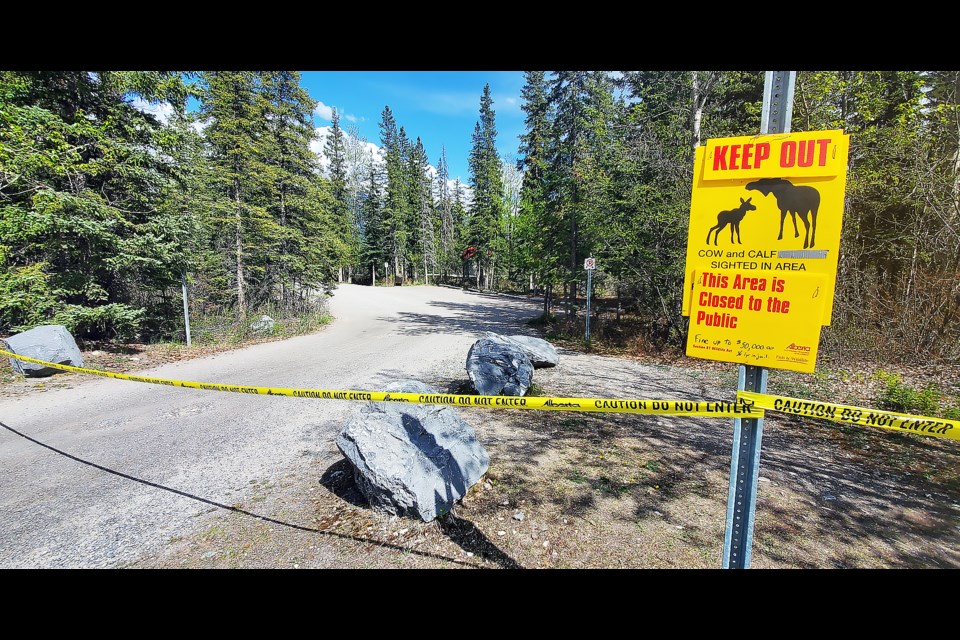CANMORE, Alta – A grizzly bear is hunting elk calves in and around town, prompting warnings to be on alert for bears and aggressive mama elk defending their young.
Provincial wildlife experts say though not common within town boundaries, bears prey on calves during the spring calving season as an early-season food source.
“Baby elk are a small bundle of tasty energy and bears key in on ungulates of all species,” said John Paczkowski, an ecologist with Alberta Parks.
“This year we’re seeing a grizzly bear in and around some of these known calving areas and it seems to be pursuing some of these calves.”
Last weekend, a large grizzly was spotted by several people chasing a cow elk near the Engine Bridge by the Bow River.
Paczkowski said the bear is untagged and without a GPS collar.
“It fits the description of a bear we’ve seen around the periphery of town,” he said.
An above-average snowpack in the mountains is keeping wildlife such as bears down in the valley bottom searching for food.
Paczkowski said remote cameras indicate there are at least six grizzly bears in the Bow Valley, both close to town and some further out.
“I think the increased snowpack and the later spring is forcing a lot more critters down low into the valley,” he said.
At this time last year, there were several cougar sightings in town, including one on the island by the power plant on the Bow River and another in a residential neighbourhood near Lions Parks mid-afternoon.
“The cow elk are defensive because there are creatures out there who want to eat their babies,” said Paczkowski.
Alberta Parks has issued a warning for provincial park lands within the Town of Canmore for the elk calving season. A spot closure is also in place in an area near the boat launch due to several close encounters between people and aggressive cow elk.
“We’ve had a few cases of people getting knocked down or approached within inches,” said Paczkowski.
“We’ve been averaging about one contact charge a year, and then last year spiked, I believe, to 11 contact charges – that’s a lot.”
Elk should not be mistaken for tame animals just because they’re in town, on golf courses, trails or playing fields. In protecting their newborn calves, female elk will charge and strike with sharp hooves.
The calves are defenceless against predators for the first few weeks of their life. Because of this, cow elk keep the newborns well hidden in bushes and shrubs, but they always stand guard not too far away.
Some signs of an agitated elk include staring with flattened ears and raised rump hair, curled lips, grinding teeth, then charging and kicking.
Residents and visitors are reminded to be aware of their surroundings, keep pets on a leash at all times, keep a safe distance of at least 30 metres, never approach elk or their calves and carry bear spray at all times.
If approached by elk, act dominant by raising arms or a big object, maintain eye contact, and never turn your back and run. If possible, climb a tree or seek safety behind a vehicle. If you are knocked down or fall, get up and try to find cover, but do not play dead.
Nick de Ruyter, program director for Bow Valley WildSmart, said elk should not be approached under any circumstances.
He said people should maintain at least a minimum distance of 30 metres, even more during elk calving.
“Just give them the space and don’t approach them for any reason, especially to take a picture…don’t put yourself in a potential dangerous situation,” he said.
“Do not try to sneak past them and this pertains to people on a bike, and people who are walking or jogging… even though you think you might be able to sneak past them, you don’t know how that elk is going to react so don’t gamble with it.”
Bear spray has also been shown to be effective against elk.
de Ruyter said he spoke with someone last week who successfully used bear spray on an aggressive female elk.
“They were cornered … the elk would not let them pass,” he said, noting there was likely a calf close by.
“They were either going to get attacked by the elk or fall into the river, and so they used the bear spray and the elk moved away and they could get to safety.”
It is thought cow elk are trying to seek a safe haven for their young from predators by giving birth in town.
But de Ruyter said the presence of newborn calves is actually attracting carnivores like cougars, bears and coyotes closer to town because for an easy meal.
“I am not surprised; it is an easy meal for carnivores and there are lots of elk cow elk that are calving right now,” he said.
“Last year it was a cougar, now there’s grizzly bears, so obviously that’s indicative of the fact that those calves do draw carnivores into town so we need to be extra careful, extra alert.”
Please report all aggressive elk encounters immediately to 403-591-7755.



